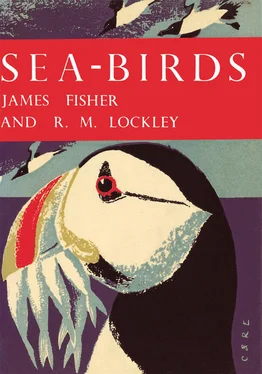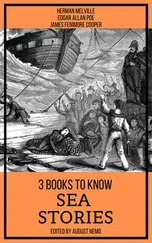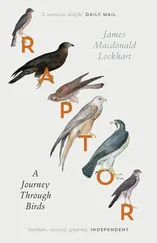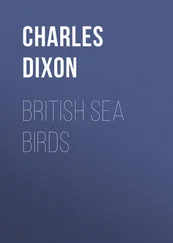1 ...8 9 10 12 13 14 ...22 The most frequent in occurrence has been the black-browed albatross D. melanophris , of which we can trace nine records. The first of these is astonishing; on 15 June 1878, north-west of Spitsbergen and north of latitude 80°N., the whaler-skipper David Gray shot one that is now in the Peterhead Museum; it was farther north than the species ever gets south, even though it nests to latitude 55°S. Another northerly record is from West Greenland, and others have been shot south-west of the Faeroes and in the Oslo Fjord, Norway; one is even alleged to have reached Oesel in the Baltic. In 1860 (Andersen 1894) a female black-browed albatross turned up among the gannets of Mýkinesholmur in Faeroe, and came to the cliff every season with them until 11 May 1894, when it was shot by P. F. Petersen. For many years the only British record was of one which was caught exhausted in a field near Linton, Cambridgeshire, on 9 July 1897; but on 14 May 1949 an immature albatross which was probably of this species was seen at the Fair Isle, between Orkney and Shetland. It was first noticed soaring off the south face of the Sheep Craig, the famous landmark on the east side of the island, and obligingly glided over George Waterston, G. Hughes-Onslow and W. P. Vicary, who got a fine view of it (Williamson 1950, 1950b). Further, in September 1952 one was picked up alive in Derbyshire (Edmunds, 1952; Serventy, Clancey and Elliott, 1953).
No other albatross has been certainly seen in Britain: a record of the yellow-nosed albatross from the Lincolnshire-Nottinghamshire boundary on 25 November 1836 is not admitted to the British list. This species, D. chlororhynchos , has been certainly obtained, however, in south Iceland, at the mouth of the St. Lawrence river, in the Bay of Fundy (New Brunswick), and in Oxford County, Maine. A record of D. chrysostoma from Bayonne in France * may possibly refer to this species, for D. chlororhynchos and D. chrysostoma are extremely similar, and almost impossible to distinguish in the field. D. chrysostoma , the grey-headed albatross, has, however, certainly been recorded once in the North Atlantic—from South Norway in 1837 (or 1834). The light-mantled sooty albatross Phoebetria palpebrata , a relatively small species which breeds on sub-antarctic islands, has been recorded from Dunkirk, France * . The greatest of all the albatrosses, the wandering albatross Diomedea exulans , has been taken, in France (Dieppe), Belgium (Antwerp) and on the Atlantic coast of Morocco; this magnificent animal has a wingspread up to 11 1⁄ 2feet and may weigh seventeen pounds or more; we can imagine the excitement of those humans who encountered these South Atlantic wanderers on their North Atlantic wanderings!
Sometimes these wanderings may end in queer places; for instance, F. J. Stubbs (1913) found an albatross that he judged to be D. exulans hanging among the turkeys of Christmas 1909 in a game-dealer’s shop in Leadenhall Market. When he saw it ‘the bird appeared quite fresh, and bright red blood was dripping from its beak.’ There was no indication whence it had been obtained.
Unidentified albatrosses have been seen at sea west of Spitsbergen on 2 May 1885, by the Captain David Gray who shot the 1878 black-browed albatross; off the mouth of Loch Linnhe, West Highlands of Scotland, in the autumn of 1884 by W. Rothschild; and twenty miles north-west of Orkney on 18 July 1894, by J. A. Harvie-Brown (1895).
Apart from the three regular non-breeding summer visitors and the albatrosses, at least six other tubenoses have wandered into the North Atlantic from the South, or from the Pacific. The Cape pigeon Daption capensis , has been recorded from France * , Holland and Maine, but the three British records have been rejected from the official list on the grounds that sailors have been known to liberate captured specimens in the Channel. Quite probably they are valid. Peale’s or the scaled petrel Pterodroma inexpectata , has once been taken in New York State. Pterodroma neglecta , the Kermadec petrel, has been once found dead in Britain (on 1 April 1908 near Tarporley in Cheshire). One Trinidad petrel Pterodroma arminjoniana , was driven to New York by the hurricane of August 1933, and possibly this close Atlantic relative of the Kermadec petrel may cross the equator fairly often, as it breeds on South Trinidad Island (only), which is fourteen hundred miles south of the equator, surely no very great distance for a petrel. One collared petrel Pterodroma leucoptera , a Pacific species, was shot between Borth and Aberystwyth in Cardiganshire, Wales, at the end of November or the beginning of December 1889. The last wandering tubenose is the black-bellied storm-petrel Fregetta tropica , a sub-antarctic species which was first collected off the coast of Sierra Leone and has also been taken in Florida. It seems likely that this last species may cross the equator fairly regularly, at least as far as the Tropic of Cancer.
One Pelecaniform wanderer has crossed the equator into the North Atlantic from South Africa—the Cape gannet Sula capensis , which may reach north to the Canaries.
From the western United States the California gull Larus californicus (which may be a race of the herring-gull, see here) winters fairly regularly to Texas, and thus (in our definition) to the North Atlantic region. Another gull which enters the North Atlantic, from more distant breeding-grounds, is the great black-headed gull, Larus ichthyaëtus of the Black Sea and farther east, which has reached Madeira and Belgium and has been seen in Britain about eight times.
Four exotic terns have wandered into the North Atlantic. The South American Trudeau’s tern Sterna trudeaui , has once reached New Jersey. On the east side Sterna balaenarum , the Damara tern of South Africa, has migrated across the equator as far as Lagos in Nigeria. Thalasseus bergii , the swift tern, breeds on the west coast of South Africa north to Walvis Bay, whence occasional individuals may sometimes pass north across the equator. The elegant tern Thalasseus elegans , of the Gulf of California, has accidentally reached Texas. And finally Gygis alba , the tropical, white, almost ‘transparent’ fairy tern breeds north in the Atlantic to Fernando Noronha, and therefore probably occasionally operates across the two hundred miles that would bring it to the North Atlantic, though there is so far no formal record of this. It has a wide distribution in all tropical seas, but is very much attached to, and does not often fly far from, its breeding-grounds; nevertheless R. C. Murphy (1936) ponders: ‘Since there are seasons when powerful southeast trade winds blow from Fernando Noronha across the equator almost as far as the mouth of the River Orinoco, speculation offers me no clue as to why Gygis has not succeeded in jumping the next gap and establishing itself in the West Indies.’
The remaining wanderers are from the North Pacific—auks from that cradle of the sub-order of auks. Aethia pusilla , the least auklet, has not actually reached the Atlantic, but one was found ‘halfway’ from the Pacific to the Atlantic, in the Mackenzie delta in May 1927. The ancient murrelet Synthliboramphus antiquus has been found three times in the Great Lakes area, but no farther east. Aethia psittacula , the paroquet auklet, * has actually reached the Atlantic by turning up in, of all places, Sweden: in December 1860 one was captured in Lake Vattern! If the least auklet has not reached the Atlantic, its congener Aethia cristatella , the crested auklet, has, for even if we reject (as most do) the alleged Massachusetts record, we must accept that of 15 August 1912 when one was shot north-east of Iceland. Finally Lunda cirrhata , the tufted puffin, was obtained by the great naturalist Audubon in Maine: other records from the Bay of Fundy and Greenland are erroneous.
Читать дальше












